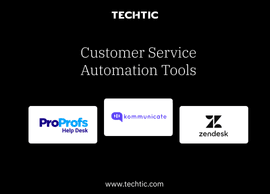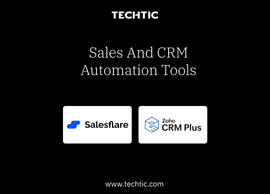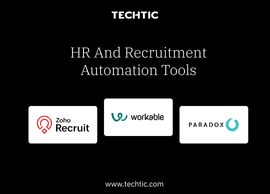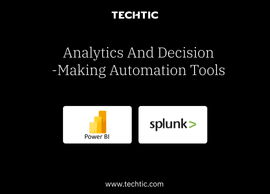Business Automation in 2025: Top Tools and Use Cases
Sector: AI + Data
Author: Nisarg Mehta
Date Published: 09/01/2025

Contents
- Workflow and Process Automation Tools: Top 3 Picks
- Customer Service Automation Tools: Top 3 You Should Know
- Marketing Automation Tools: The 3 Game-Changers
- Sales and CRM Automation Tools: 2 Tools That Make Sales Smoother
- HR and Recruitment Automation Tools: 3 Top Tools for 2025
- Analytics and Decision-Making Automation Tools: 2 Smart Solutions in 2025
- Getting Started with Business Automation in 2025 (Conclusion)
- FAQs
It’s hard to miss how much automation is changing business these days. Banks now catch bad transactions almost instantly, so customers don’t have to worry about security slips. Doctors spend more time with patients, not paperwork, thanks to software that organizes medical info without fuss. On the factory side, smart sensors warn about equipment problems before they turn into expensive repairs.
For smaller companies, the switch to automation has become a practical move, not just a tech trend. Owners aren’t stuck sending reminders for late invoices or fussing over endless customer emails. Handing those chores to programs like Power Automate or Zapier means folks can focus on growing their business. Saving time is great, but what really matters is keeping up with the competition.
With that in mind, let’s look at the top AI tools that you can use in 2025 to automate your business.
A. Workflow and Process Automation Tools: Top 3 Picks
When it comes to automating workflows in 2025, there are a ton of options out there. But to keep things simple, here are three popular tools that many small and mid-scale businesses lean on, and for good reason.

1. Zapier
Think of Zapier as the go-to for just about anyone who needs to connect their apps without any fuss. It’s got a massive library of over 7,000 apps, like Gmail, Slack, and Google Sheets, and lets you set up simple rules, which they call “Zaps.” Want to automatically save an email attachment to a cloud folder? Or maybe get a Slack notification whenever a new sale comes in? Zapier makes that whole process painless.
What really gets people on board with Zapier is how simple it is. You don’t have to be a tech expert to set up an automation. The setup is all drag-and-drop, so you can build workflows with multiple steps and conditions, making things as simple or as complex as you need them to be. The only real catch is that it can get a bit expensive if you’re automating a whole lot of tasks. Still, the time you save often makes up for the cost pretty quickly.
2. Make (formerly Integromat)
Make is the flexible tool for those who want to go a bit deeper. It also offers drag-and-drop automation building but with more options to customize how data flows between apps. If you need some custom scripting or want to build complex routes for your data, Make lets you do that.
The flip side: The great power comes with a bit of a learning curve. It’s not as instantly friendly as Zapier, but once you get the hang of it, the possibilities are almost endless. Plus, it integrates with over 2,000 apps, plenty for most businesses.
3. Workato
Workato plays in the big leagues, often favored by businesses that want not just automation but serious integration across departments and systems. It supports robust connections to cloud apps like Salesforce, SAP, and Slack and lets you build automation “recipes” that can include multiple steps and complex conditions.
Heads up: It’s a bit more enterprise-focused and can be pricier, but if your business relies on several software platforms working together, Workato is a powerhouse that can handle it all securely and efficiently.
B. Customer Service Automation Tools: Top 3 You Should Know
Customer service can be a real headache, especially when customer questions keep piling up. The bright side? AI-driven customer service tools are stepping up to make the load lighter, often handling half or more of the routine queries automatically. Here are three tools worth checking out:

1. ProProfs Help Desk
ProProfs Help Desk is a smart choice if you’re looking for a support agent that’s on duty 24/7. It uses AI to do a lot of the heavy lifting, like summarizing long customer chat histories, suggesting quick responses to agents, and even flagging tickets that need immediate attention. Small businesses especially like it because it keeps all customer inquiries, from emails to live chat to web forms, neatly organized in one place, so nothing ever gets lost. Best of all, they have a free plan that’s generous enough to let a single agent get started.
2. Kommunicate
If you’re thinking about a full-on AI chatbot, Kommunicate is a good one to look at. It specializes in conversational AI that can handle a ton of back-and-forth across platforms like WhatsApp, Instagram, and even phone calls. It’s perfect for businesses that want to give customers instant answers at any hour and lighten the load on their support staff. The best part is that you can build the chatbot yourself without any coding, and you can even train the AI on your own knowledge base to make its responses smarter over time.
3. Zendesk
Zendesk has been a leader in customer support for a while, and its AI features show why. It’s a powerhouse ticketing system with some serious automation baked in. The AI bots are smart enough to understand a customer’s question, find the right answer in your knowledge base, and sometimes even close a ticket completely on their own. It’s the kind of platform that can easily grow with your business and gives you all the tools for personal, on-time customer service.
C. Marketing Automation Tools: The 3 Game-Changers
Here are three standout tools small and mid-sized business owners are turning to in 2025:

1. HubSpot Marketing Hub
HubSpot is a bit of a legend in the automation world, and for good reason. It’s an all-in-one platform for both marketing and CRM, letting you manage everything from email drip campaigns to social media posts. The visual builder is easy to use, and it’s a platform that’s built to grow with your business. HubSpot also handles things like lead scoring and personalized marketing, plus they have a huge library of tutorials to help you get the hang of it quickly.
2. Omnisend
For businesses that are all about e-commerce, Omnisend is a great fit. It does more than just email marketing by also adding in SMS and push notifications. It has unique features to help you engage customers, like sending them email gift boxes or scratch cards. The automation builder is intuitive with plenty of ready-to-go templates, and the omnichannel approach means you can reach customers wherever they are for a lot less hassle. The best part is that the free plan is pretty generous, so you can start right away.
3. ActiveCampaign
If you need something that ties together your email marketing, sales, and CRM, ActiveCampaign is a solid option. People know it for its killer automation workflows that can trigger emails, score leads, and manage a customer’s entire journey based on their behavior. For small businesses, it gives you a ton of value and has a reputation for great customer support.
D. Sales and CRM Automation Tools: 2 Tools That Make Sales Smoother
Sales automation tools these days are like having a smart assistant who never sleeps, helping you track leads, follow up automatically, and close deals faster. Let’s highlight three popular picks for 2025 that are making waves among small to mid-size businesses:

1. Salesflare
Next up is Salesflare. This tool is designed to feel like you have a friendly sales assistant doing all the busywork of managing your contacts. It automatically pulls in all the details for you from emails, your calendar, social media, all of it. That means you don’t have to manually type in a thing. It’s perfect for smaller teams who want something smart but also super simple to use.
Why users love it: Minimal manual data entry, intuitive interface, and AI reminders that help you follow up leads at just the right time. The downside is that some people might feel sharing all their communication data is a bit too transparent within the team, but it’s been improved with permission controls.
2. Zoho CRM Plus
If you’re after a lot of power without the high price tag, take a look at Zoho CRM Plus. It really packs a punch, putting all your sales, marketing, and customer service needs into one spot. It even has its own AI assistant, Zia, that can do some impressive things like figuring out which leads are the hottest or automating little tasks to speed things up. It’s got all the communication channels you could need, and you can easily customize it to fit your business. For a growing company that wants a flexible platform without a big learning curve, this one’s a good fit.
E. HR and Recruitment Automation Tools: 3 Top Tools for 2025
Hiring new people can feel like a huge puzzle. These HR and recruiting tools are here to make it a lot less painful.

1. Zoho Recruit
Zoho Recruit is a flexible system that works for all kinds of teams, whether you’re at a staffing agency or in an in-house HR department. It takes care of a lot of the manual stuff, like getting information from resumes, setting up interviews, and sending follow-up emails. That frees up your recruiters to focus on what’s important: finding the right person for the job.
Plus, you can customize the workflows to fit how you like to hire, and it connects with all the major job boards so you can post your openings with just one click. It’s also pretty affordable, with a free plan to get you started. The only thing to watch out for is that it has a bit of a learning curve, and some features like bulk emails or client portals will cost you extra.
2. Workable
Then there’s Workable. It’s an all-in-one hiring platform known for how easy it is to use and for its powerful AI that helps you find candidates. It gives you access to millions of profiles and can post job openings across a ton of different channels with no hassle. What makes it a favorite is how it simplifies evaluation and collaboration among hiring teams.
A tip: Pricing can be on the higher side, especially for larger teams, but the platform’s features are worth the investment if hiring is a priority.
3. Paradox
Paradox brings recruiting to life with its AI assistant, Olivia. She’s designed for companies that have to hire a lot of people, like in retail or healthcare. Olivia can handle the whole first part of the process, having conversations, screening candidates, setting up interviews, and answering basic questions. This frees your recruiters up from all the repetitive tasks. The chat-based interaction feels really natural and is easy for candidates to use, which helps things move along smoothly. This is definitely for companies that get a ton of applicants and need fast, consistent communication.
F. Analytics and Decision-Making Automation Tools: 2 Smart Solutions in 2025
Data can be a goldmine if you know how to dig it up, and modern analytics automation tools do exactly that, turning complex data into actionable insights without making you a data scientist first. Here are three highly regarded tools helping businesses in 2025 make smarter decisions effortlessly:

1. Microsoft Power BI
Microsoft Power BI is a powerhouse for data. Small to mid-sized businesses love it because it connects to dozens of different data sources. You can build interactive dashboards easily with a simple drag-and-drop tool, and it even has some AI features that can automatically find trends for you. If you’ve used other Microsoft products, it’s an easy transition. And the free and affordable plans let you try it out without any big financial risk.
2. Splunk
Splunk started out for machine data but has since grown into a powerful platform for real-time analysis across all kinds of businesses. It’s great at pulling in, indexing, and visualizing big streams of data to keep an eye on operations and catch problems instantly. It’s the tool of choice when live operational intelligence really matters, like for IT performance monitoring or security. While it can be a bit complex to set up, its power is unmatched for businesses with a lot of fast-moving data.
Getting Started with Business Automation in 2025 (Conclusion)
Taking the leap into business automation can seem daunting at first, but breaking it down into clear steps will make it manageable, and rewarding. Here’s a straightforward roadmap to help your business start reaping automation benefits sooner rather than later:
- Find the busywork. Look at your day. Which tasks eat up a ton of time but don’t require much thought, you know? Like all that data entry or sending a bunch of follow-up emails.
- Then, you choose a tool. The best bet is to start with those easy, no-code platforms. You can always check out the more advanced tools later if you need to.
- Now you try it out. Just grab a free trial. You should start by automating one or two simple things to build confidence.
- Train your team. Make sure your employees are on board and feel supported. Good training helps everyone embrace it as a way to be more productive.
- Keep an eye on it. Automation isn’t “set it and forget it.” Track how things are working, get feedback from your team, and fine-tune your workflows.
For the best results, partnering with experienced business automation experts can make all the difference. Companies like us specialize in understanding your operations and deploying tailored automation solutions that fit perfectly and deliver maximum ROI.
So, don’t wait… reach out to Techtic Solutions to get started the right way and unlock your business’s full potential in 2025 and beyond.
FAQs
Q: What is business automation and why is it important?
Business automation is the use of software, AI, and digital tools to handle repetitive and time-consuming tasks such as invoicing, data entry, customer support, marketing, and HR management. It’s important because it saves time, improves accuracy, lowers operational costs, and allows teams to focus on strategic tasks that drive growth. Businesses that embrace automation gain a competitive edge by increasing efficiency and enhancing customer satisfaction.
Q: What challenges do businesses face when adopting automation?
Common challenges in adopting automation include:
- Resistance to change from employees.
- Choosing the right automation tools for specific needs.
- Initial setup and training requirements.
- Integration with existing software.
- Over-reliance on automation without human oversight.
- With proper planning, training, and expert guidance, most of these challenges can be minimized.
Q: How do I choose the right business automation tool?
To choose the right automation tool, businesses should:
- Identify repetitive tasks that consume the most time.
- Look for tools that integrate with existing software.
- Start with no-code or low-code platforms for easier adoption.
- Consider scalability and future business needs.
- Test free trials before committing to paid plans.
Q: What is the difference between business automation and AI automation?
Business automation uses software to handle repetitive, rule-based tasks such as invoicing or email scheduling. AI automation goes a step further by applying artificial intelligence to make decisions, learn from data, and handle complex tasks like predictive analytics or natural language customer support. Together, they help businesses achieve smarter and more efficient workflows.



